| GENETICS OF CANINE SIZE |
| I'm sure at least some of you
have wondered at the
amazing variation in size
when looking at Chihuahuas.
How is it that two normal
sized, or even quite large
parents produce a tiny
offspring? |
| It's pure genetics: |
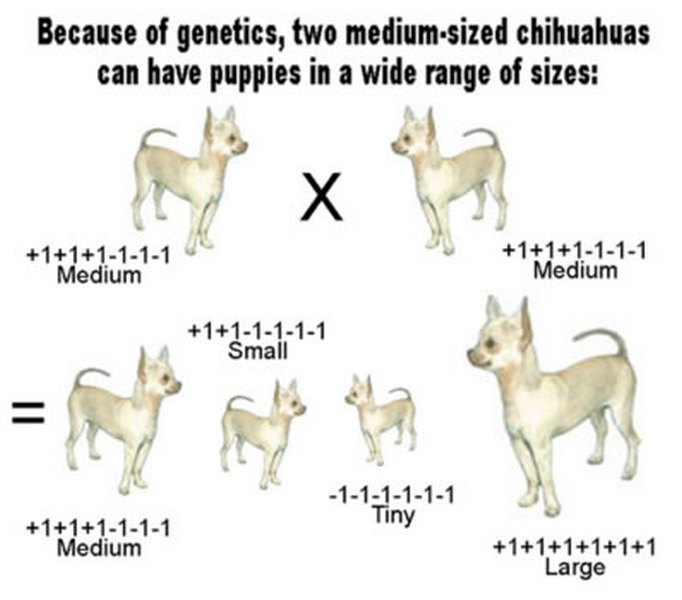 |
The gene that controls chihuahua size has six parts, or alleles, and each parent passes on three of theirs to the offspring. Size alleles can be best described as having a value of either + (positive) or - (negative). The six
"values" of the alleles are combined for a total, which determines size.
For example: +,+,+,-,-,-, = 6 alleles, or 3 positive and 3 negative. Think of + as "up 1", and - as "down 1."
The first three positives cancel out the next three negatives (+1+1+1-1-1-1 = 0), so we end up with 0, or your
proverbial "average".
Another example: +,-,+,-,-,-. Added together, we get 2 up and 4 down, with an end result of -2, "2 down", or
below average size. (+1+1-1-1-1-1 = -2)
One more. +,+,+,+,-,-. 4 up and 2 down = +2, or "2 up".
(+1+1+1+1-1-1 = 2) In other words, a bigger than average pup.
Are you starting to get the idea? Ok, let's start passing things on to the kids.
Take two, average sized parents: Dad = +,+,+,-,-,- and Mom = +,+,+,-,-,-. Let's give them a litter of 3.
Pup #1: Take (at random) 2 minuses and 1 plus from Dad and 1 minus and 2 pluses from Mom. So, Pup #1
is -1,-1,+1,-1,+1,+1. The total is 0, or average size... an average size pup from 2 average sized parents. Not
surprising.
Pup #2: Take (again, at random) 3 minuses from Dad and three minuses from Mom. What size pup do we
get? Pup #2 is -1,-1,-1,-1,-1,-1. The total is -6, or one very tiny puppy – the term “teacup size” is often used
to describe this size of puppy.
Pup #3: Let's have all the pluses that both Mom and Dad can give (this combination can also happen
randomly). That's +1,+1,+1,+1,+1,+1 = 6, and results in a chihuahua much larger than either parent.
When you see how size is inherited, it all starts to make sense doesn't it? But genetics is only part of the
story with regard to size.
It has been well documented that the human race is getting bigger and taller with each generation. When
you look through museum reproductions of early settler's cottages, the height of doorways and the length of
beds stand out as being quite small by today's standards.
This gradual, but steady increase in the size of humans has been attributed by scientists to improvements in
diet and health care over the years. Diet is just one factor in what is generally referred to as "environment",
and environment plays a major role in the size of chihuahuas as well. Proper nutrition, maternal care,
warmth and exercise all contribute to growth in a puppy.
The last variable in determining size is a congenital factor affecting growth. New research from the Canine
Genome Project has shown a link between size and thyroid development. What is not clear yet is whether
size is affecting the development of the thyroid or the development of the thyroid is affecting size. It is well
documented, however, that the very tiny examples of our breed have more frequent and serious health
problems than normal sized chihuahuas.
Where does the term TEACUP, POCKET SIZE, MINIATURE come from? |
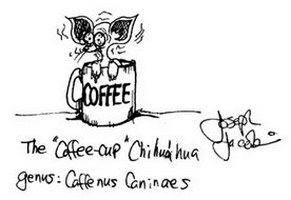 |
There seems to be quite a bit of confusion and misconception regarding these terms.
Chihuahuas as with humans come in different sizes as we have just discovered in the
information above due to their genetic build up. Most breeders proclaim outright there
is no such thing as a teacup, pocket size or miniature Chihuahua. The breed standard
does not make any allowance for anything else but “smooth coat” or “long coat”. But
the fact can’t be denied that some are bigger and some are smaller and people have
started to use these terms to describe the ones referred to as “tiny” in picture of
genetics above. It should be clearly understood that this is certainly not a separate or
special or different type of breed.
These very tiny dogs are very scarce though and sometimes difficult to raise as very
often they may have health problems which may have caused a problem in their growth
in the first place and these puppies also require very special care and attention. I do
get them from time to time but not on a regular basis, because of their tiny size they
are very sought after. I do keep them for a longer period of time to ensure they are in
100% perfect health before they leave.
The term “pocket size” is not used to describe an item of clothing (though as can be
seen in this photo out of the archives small Chihuahuas has been used to advertise
ladies shoes!).
|
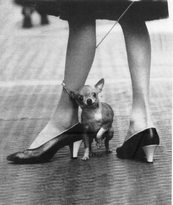  |
| It is used to refer to a puppy who at age of about 6 weeks fits loosely into a man’s shirt
pocket, as can be seen in these photos, they generally weigh in the region of
approximately 2kg or less as adults. |
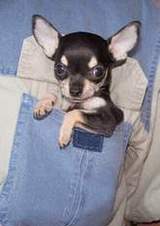 |
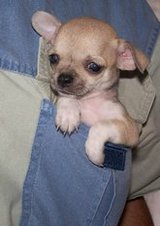 |
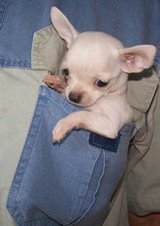 |
| The term “teacup size” is used to refer to a puppy who at age of about 6 weeks fits into
a cup, as can be seen in this photo, they can weigh in the region of approximately
1.5kg-1.8kg as adults. It should be noted that these puppies are definitely not
recommended for breeding and Chihuahuas are never a toy for small children either. |
 |
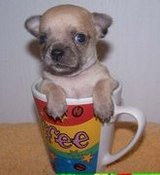 |
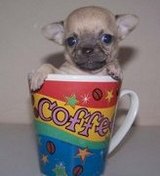 |
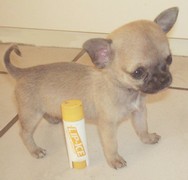 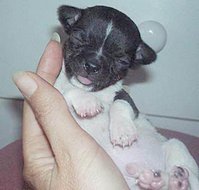 |
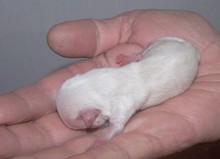 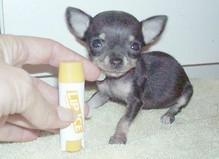 |
| The term “teacup size” does not mean “having afternoon tea with the old ladies” either,
though looking at the following photo out of the archives it seems the tiny Chihuahua
was a welcome guest at the tea party even in years gone by… |
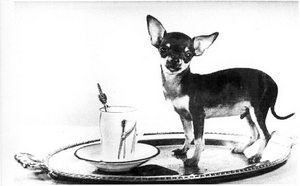 |
|
|